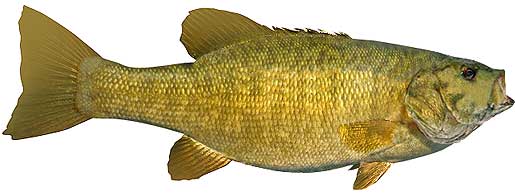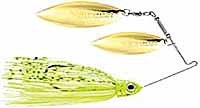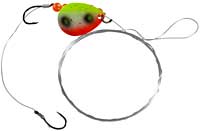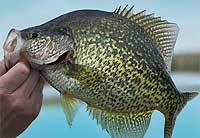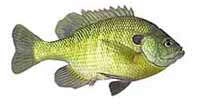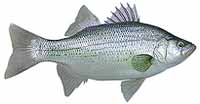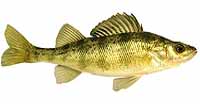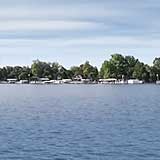Fishing Report For West Okoboji Lake, IA
By Rick Seaman
August 29, 2025
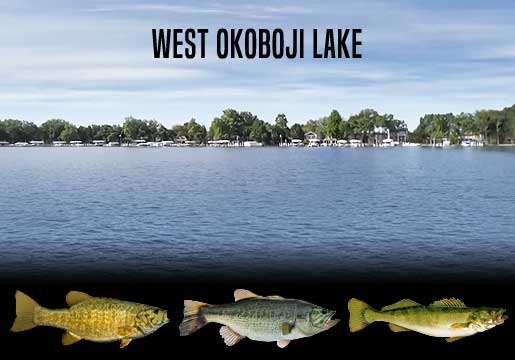
Fishing Reports
Popular Fish Species West Okoboji Lake, IA
Smallmouth Bass
Current Report: Good To Very Good
SUMMER. In Simmer, smallmouth bass, including many trophy-size gems, feed shallow early and late in the day, where they are being caught on topwater, crankbaits, swimbaits, Ned rigs and tube baits. Smallmouth bass here feed on crawfish, gizzard shad, and small sunfish. They prefer rocky or gravel bottom areas, as this is where crayfish live. During the hotter parts of the day, they are typically caught on points, humps, and ledges 10 to 30 feet deep. Often these deeper fish are part of a large school.
FALL. As Fall arrives, smallmouth here follow schools of baitfish into coves, bays, and shallow flats where topwater, chatterbaits, crankbaits, and slow-rolled spinnerbaits, are very successful. Fishing shallow for smallmouth is often good on cold, windy, cloudy and rainy days.
WINTER. Before the lake freezes over, and again after ice out, smallies will hold around deeper structure, points and creek channels. They can generally be found from 20 to 50 feet deep. Here they hold, feeding less frequently, awaiting warmer water to return in Spring. Ice fishing for smallmouth is an option, but most ice fishing anglers focus on other species.
SPRING. When water temperatures rise into the 40's, smallmouth will have moved from deep wintering habitat to shallower water, just outside spawning areas. They feed heavily at this time, and are typically caught on jerkbaits, crankbaits, blade baits, tube baits, Ned rigs, and crayfish imitating plastics. They will be preparing for the spawn. Once water warms into the high 50's, they move into shallower water, and create nests in gravel or sand areas, then lay their eggs. Females then move to deeper water and males remain to guard the eggs, and then the fry. After a couple weeks, the males also move to slightly deeper water and feed aggressively. Crankbaits, tube baits, Ned rigs, plastic worms, spoons and swimbaits are catching smallies during this period.
Largemouth Bass
Current Report: Good To Very Good
SUMMER. Water temperatures are cooling, so summer patterns are fading. In the heat of Summer, bass were feeding shallow early and late in the day, where they are being caught on topwater, vibrating jigs, crankbaits and swimbaits. Wacky-rigged stick worms catch finicky largemouth when the bite is slow. Bass here feed on gizzard shad, small sunfish and crawfish. During the hotter parts of the day, they are being caught on points, channel edges, and ledges 10 to 25 feet deep. They are also being caught in the shade of docks, especially those with brush piles.
FALL. With Fall arriving, largemouth bass here also follow schools of baitfish into coves, shallow bays and on shallow flats where swimbaits, jerkbaits, lipless crankbaits, and slow-rolled spinnerbaits are ideal baits. As deeper water cools, bait and bass move out to ledges, channel edges, points and humps where flutter spoons are often the ideal bait.
WINTER. In early Winter, and after ice out, largemouth will isolate around slightly deeper structure, flats, points and creek channels. They can typically be found from 20 to 30 feet deep. Here they hold, feeding less frequently, awaiting warmer water to return in Spring. Ice fishing for bass is an option, but most ice fishing anglers focus on other species.
SPRING. Once water temperatures rise into the low 60's, largemouth will move from deep wintering holes, to shallower water nearby spawning areas. Jerkbaits, spinnerbaits and vibrating jigs typically get bites just away from the shoreline. At this time they are feeding aggressively and preparing for the spawn. Once water warms into the mid to high 60's, they will move into 1 to 4 feet of water, and create nests, then lay their eggs. Once the eggs are deposited in the nest, females move to deeper water and males remain to guard the eggs, and then the fry. After a couple weeks, the males also move to slightly deeper water. Crankbaits, vibrating jigs, plastic worms and swimbaits are catching bass during this period.
Walleye
Current Report: Fair To Good
SUMMER. Currently the water temperature is beginning to cool, and walleye fishing is picking up. Throughout Summer, early in the morning, and from dusk to long after dark were good times to catch walleye. At those times they move shallow to feed in low-light conditions. Night fishing has been good, as well. The rest of the time they are cruising flats and creek channel edges, where they are typically caught on minnows, grubs and nightcrawlers, fished just off the bottom.
FALL. As Fall is arriving it brings cooler temperatures to shallow water, drawing walleye and baitfish up from deeper areas. Jigs, swimbaits, spoons, crankbaits, jerkbaits, and spinnerbaits are all historically good for catching walleye again. Major lake points like Gull Point, Manhattan Point and other long points are good places to start a search for walleye. Later in Fall, they move out deeper again. Dragging bottom bouncers, jigs, or worm harnesses with nightcrawlers or leeches, around ledge drop-offs catches walleye fairly consistently. Often the bigger walleye will be slightly deeper than the majority of the school.
WINTER. Last Winter, fishing for walleye was quite good through the ice. Anglers report catching them in 4 to 15 feet of water, along weed lines. They primarily feed on gizzard shad and small fish, staying close to the bottom. After ice-out blade baits, jigs, swimbaits, spoons, deep-diving crankbaits, and worm harness spinners, are all working while trolling or slow drifting. Most walleye are coming out of 8 to 15 feet of water during late winter.
SPRING. Walleye will begin moving to rocky areas in 5 to 12 feet of water, where they begin feeding in preparation for the spawn. Shallow areas next to deep water are key locations at this time. Here they will spawn once the water warms to the mid to high 40's. Afterwards, they move to shallow points, flats, shoals and ledges, just off shore and nearby their spawning locations. Early and lake in the day, or on cloudy days, feeding activity improves in these low-light conditions. Bright colored jigs, tipped with minnows or nightcrawlers are always a good option. Spinnerbaits, jerkbaits and crankbaits are also working when walleye are up shallow.
Fishing Video
Fish species to fish for...
Guide to fishing for largemouth bass, smallmouth bass, channel catfish, black crappie, walleye, bluegill, white bass, yellow bass, yellow perch, muskie and northern pike at West Okoboji Lake in Iowa.
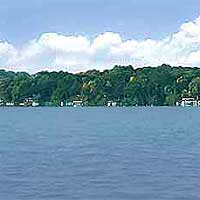
West Okoboji Lake is a 3,850-acre lake with over 20 miles of shoreline. The lake offers excellent bass, walleye, northern pike and bluegill fishing. In addition, catfish, crappie, sunfish, perch and muskie thrive here. There are plenty of opportunities for fishing from the bank, and there's great ice fishing in winter.
Primary fish species to catch
Click images for fishing tips and details about each species.
Today's Weather & Forecast
Fishing Boat Rentals
Click here for fishing boat rentals.
Public Boat Launch Ramps & Landings
Click here for boat ramps.
Marinas
Click here for marinas.
Fishing License
Click here for an Iowa Fishing License.
Map - Fishing & Access
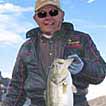
Rick Seaman is a fishing enthusiast with over five decades of fishing experience, a retired tournament fisherman, author of numerous published articles on fishing, and co-author of the book "Bass Fishing - It's not WHAT you throw, It's WHERE you throw it".
Contact Information
Gull Point State Park
9RCJ+FC Wahpeton
Lakeville, IA
712 337-3211
Fishing lakes in each state
082925
West Okoboji Lake, Iowa Report
IOWA


Information about fishing lakes in Iowa
Fishing in northwest Iowa for bass, crappie, walleye, perch and northern pike.


